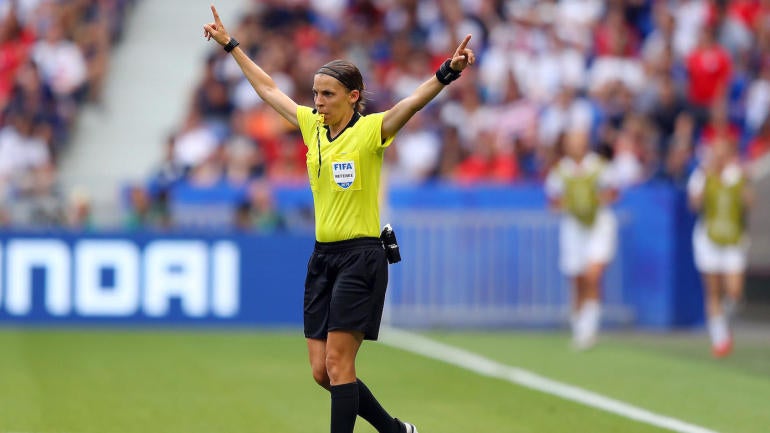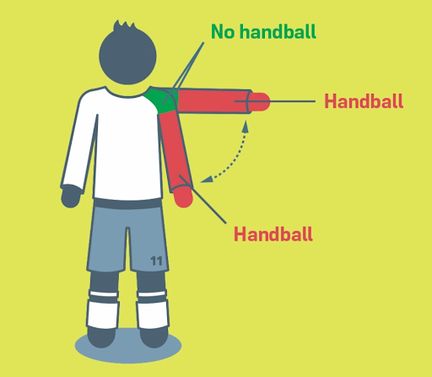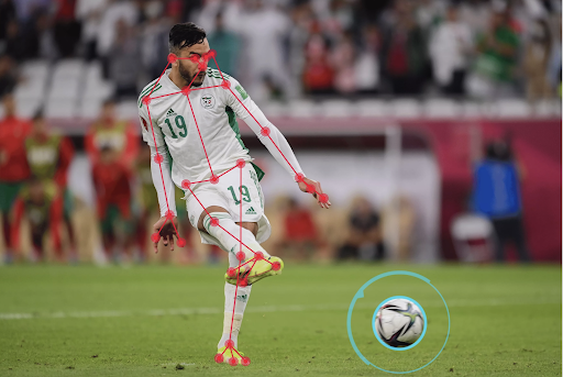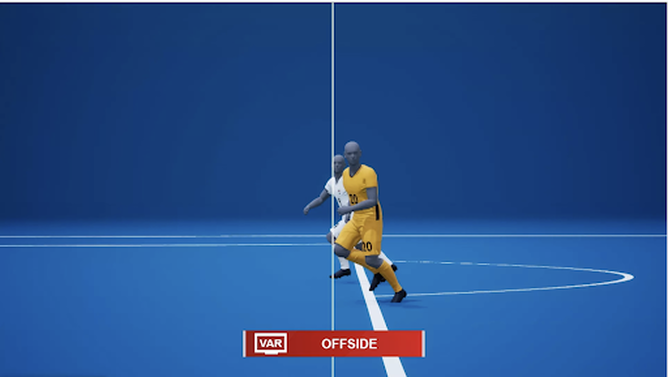
The FIFA World Cup is the Big Dance. The big international dance. Every four years, it captures the entire attention of the world. Including those who don't normally watch soccer.
This year, the United States men's national team are in the tournament for the first time in eight years, and more American eyes will be watching who are not so familiar with the beautiful game but have come to support their fellow Americans.
So, from my first hand experience refereeing at the highest level, here are the five things you need to know from their perspective of the rules (it's actually the "Laws of the Game" but I'll toss that one in for free) to appreciate the game and make you sound like an expert.

Golazo Starting XI Newsletter
Get your Soccer Fix from Around the Globe
Your ultimate guide to the Beautiful Game as our experts take you beyond the pitch and around the globe with news that matters.
Thanks for signing up!
Keep an eye on your inbox.
Sorry!
There was an error processing your subscription.
Handling
The most misunderstood law of the game because of how "discretionary" a call it can be. It doesn't help that in the past year, international referees have been advised to strictly apply a law that feels "unfair" in some contexts.
First, see the diagram below. Shoulders are no longer considered part of the "arm" for handling offenses like they used to be.

Second, not every touch of the hand/arm is considered a handling offense. There are situations and contexts that do not call for it to be penalized, such as when the player has the arm "tight" or "close to their body" and does not make themselves "larger" or move it to be "outside the silhouette." See the diagram below, and the great Thierry Henry, Jamie Carragher, and Mikah Richards get a breakdown. And remember for more of the Paramount+ guys, every Champions League, Europa League and Serie A match you can sign up to Paramount+ using offer code ALLYEAR for 50% off the annual plan.
However, if you still find yourself debating whether or not a handling offense occurred with others at a bar with friends or family, congrats you're just like every other soccer fan all over the world. Welcome to the soccer community.

Finally, any goal directly scored by the hand or arm, regardless of whether deliberate or not, will be disallowed.
Video Assistant Referee
In America, we are familiar with video technology assisting officials and umpires in correcting game-critical decisions in other major sports like American football, baseball, and basketball. In soccer, it is still in its infancy, as this is the second Men's World Cup which has the technology. The first was in 2018 in Russia. However, in between World Cups, Video Assistant Referee ("V.A.R." - properly pronounced by its letters instead of one word), has been part of major men's professional soccer and at major FIFA tournaments. The officials are very familiar and comfortable with the technology and its use.
There is a main VAR in the Video Operating Room who is assisted by 2-3 assistant VARs and 2-3 video operators. The main VAR is ultimately responsible for determining whether, in his opinion, a "clear and obvious error" has been made by the on-field officials after reviewing the video footage and providing a recommendation to the main center official to review their decision whether at the video monitor near pitchside (field side), or in some cases the referee can accept the VAR's verbal recommendation.
What incidents does the VAR check? VAR will be used only for "clear and obvious errors" or "serious missed incidents" in four match-changing situations: goals, penalty decisions, direct red-card incidents, and mistaken identity.
Goals. Any goal or no goal is automatically reviewed by the VAR to determine whether there were any fouls leading up to the goal, which would disallow the goal, offside before the goal, or ball in/out of the field that was missed.
Penalty Decisions. Whether given or not given, any potential fouls are reviewed by the VAR concerning the tackle, offense, and location of the foul, whether inside or outside the penalty area.
Direct Red Card. Whether given or not, red card challenges or potential red card challenges are automatically reviewed. A second yellow card that turns into a red card is not reviewed.
Mistaken Identity. A card given to the wrong individual can be reviewed and corrected.
Communication with viewers on T.V. is steadily getting better but what you will see is a graphic indicating VAR is in process and when it is "over" or an official recommendation is being communicated to the main on-field center referee.
Semi-Automated Offside Technology
Speaking of graphics, welcome to VAR 2.0, which includes "limb tracking technology" that at all times throughout the game tracks every player's body part and a sensor in the official Qatar Adidas world cup ball, Al Rihla (yes, the ball is named in soccer at major tournaments), to track to the exact moment when the ball is kicked. Twelve cameras are solely dedicated to tracking up to 29 data points of each individual player, 50 times per second, calculating the individuals exact position on the field. This is relevant to assist the VAR in reviewing tight offside calls.

One of the most critizied parts of VAR are plays where an attacker is in an offside position by only centimeters which disallows a goal. This new technology further reduces any claim for human error on agonizingly tight offside calls as the technology automatically alerts the VAR to the offside to which the VAR verifies the offside and recommends it to the on-field referee team.
A 3-D graphic is then created to prove the offside decision to viewers and in stadium fans.

Offside
So what is actually offside in soccer? It is when the attacking player is in the opponents half and is closer to the goal line than the second to last opponent (two defenders between the goal line and the attacker) and the ball when the ball is first touched or played by a teammate and the attacking player becomes involved in the play, interferes with an opponent or gains an unfair advantage by being in that offside position.
Simple right?
The two areas that make it complicated are some exceptions to the rule regarding deliberate vs. deflection plays by defenders that "resets" the moment offside position is determined, and how tight these decisions can be. For the deliberate vs. deflection play, that is another article all to itself, but the tight calls are to be fixed by Semi-Automated Offside Technology which you are now an expert in and you now know why the players exact location of their body parts matter and when the ball is actually first played or touched by an attacker's teammate matters.
Yellow and Red Cards to Team Officials
The ability for referees to give yellow and red cards to coaches and other team officials on the team bench is a newly introduced concept to the soccer game that didn't exist in the laws of the game in the last FIFA World Cup.
Pretty straightforward, this clearly communicates to the antagonists and the world when a coach or team official has crossed the line of respectable behavior. Before, referees only had the ability to verbally warn coaches and team officials before being able to dismiss individuals from the game (unless the action was at a level that allowed for a direct dismissal). This new introduction for referees to manage sideline behavior is very effective as it draws a clear line, similar to players, when their actions are no longer acceptables.
So now, everyone who steps on to the pitch, can see a yellow or red card.
BONUS - Women Referees in Men's FIFA World Cup for the First Time
Stepping on to the pitch for the first time in a FIFA Men's World Cup in Qatar are six women referees as both center main referees and assistant referees. In the soccer world, these women have been trailblazing and over the past four to eight years and have been proving themselves as some of the top officials in the world regardless of gender. Referees who have been on FIFA Women World Cup Finals, Olympic tournaments, FIFA Club World Cups, FIFA Youth World Cups, their confederations Finals and major tournaments, to even the top division and finals of both men and womens professional soccer in their respective countries.
Three main center referees is headlined by French referee Stephanie Frappart, first woman to take charge of a UEFA Champions League match, with the other two, Rwanda referee Salim Mukansanga and Japan referee Yoshimi Yamashita joining her.
Three assistant referees ("ARs") join them, Brazilian AR Neuza Back from Brazil and Mexico's Karen Diaz Medina, and importantly, America's very own Katy Nesbitt.
Katy Nesbitt is a trailblazer for all officials in men's professional sports. In 2020, she was the first woman to referee a championship match in a major men's professional sports league in North American in both the MLS is Back Tournament Final and the MLS Cup. She carries that distinction as well as having been named the first woman to win MLS Assistant Referee of the Year.
Stepping into the highly competitive, international soccer referee world, Katy Nesbitt not only has proven she belongs domestically at the professional levels, she has transcended the international men and women's scene at FIFA and is an aspiring trailblazer to change perspectives of men and women. Under One Nation. One Team. She is an American we throw our full support behind and root for her and her fellow American referee colleagues to have a successful FIFA World Cup in a country that does not recognize women as equal counterparts of society.





















